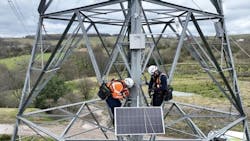National Grid Installs Grid-Enhancing Technology for More Renewable Power Through Existing Transmission Lines
National Grid has partnered with LineVision, a provider of non-contact overhead power line monitoring systems, for the deployment of dynamic line rating (DLR) sensors on circuits between one of the major North-South power system boundaries to expand the capacity of its existing overhead power lines.
The new technology covers five circuits between Penwortham (Preston) and Daines (Manchester) and four circuits from Norton (Middlesborough) to Thornton (York), together increasing the capacity of over 275 km of overhead line conductor.
The technology has the potential to save consumers around $27.12 million per year, by helping to deal with challenges on one of the leading boundaries for constraint costs on Britain’s transmission network. The installation has the potential to release enough additional capacity to power 75,000 homes a year, and is part of National Grid’s ongoing investment to increase the grid’s capacity and connect the renewable power required for Britain to reach its net zero target by 2050.
The installation is followed by successful implementation of LineVision’s DLR equipment on a 275 kV circuit between Penwortham and Kirkby in Cumbria and the execution of LineVision technology on National Grid’s networks in New York and Massachusetts.
While LineVision is part of the National Grid Partners investment portfolio, attaching LineVision sensors to continually monitor electricity transmission lines provides continuous data in order to calculate a dynamic line rating (DLR). The rating is used to maximize the amount of power safely transmitted through that transmission line.
The dynamic line rating is determined by a power line’s physical and electrical properties, which includes size, resistance and maximum safe operating temperature, as well as the local weather conditions. LineVision’s dynamic line ratings determine capacity limits by combining real-time conductor properties and forecasted weather conditions for more informed grid operations and safely increasing operational limits.
Additionally, National Grid is deploying technologies like advanced power flow controllers, which instantly routes power through the circuits which have available capacity, and using drones and Artificial Intelligence (AI) to monitor overhead lines daily. The works form part of wider upgrades to increase the capacity of the network and help connect more renewable energy to homes and businesses, which also includes building new infrastructure as part of The Great Grid Upgrade.
